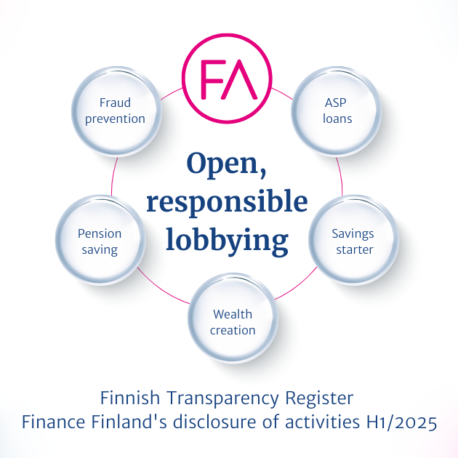
- A substantial amount of financial sector regulation comes from the EU.
- Hastily prepared regulation causes many problems, and the amount of regulation is ever increasing. Is all of it really necessary?
- Cost estimates of regulation have room for improvement – both from the regulators and the sector.
- Best results are achieved by involving key stakeholders in the legislative process.
Lea Mäntyniemi, FFI’s director of legislation, retired this May. She worked at Finance Finland and its predecessors for more than 40 years. In this interview, she discusses a number of issues in current regulation and the ways the preparatory process could be improved.
In recent years, EU regulation has been marked by haste, and a similar sense of urgency has not been unfamiliar in national law-making, either. Tight timetables affect the quality of legal texts, sometimes to the point of making them difficult to understand. Having followed these processes for years, Lea Mäntyniemi notes with regret that the EU tends to fix a regulation’s implementation date too early in the process. This does not leave enough time to prepare supplementary lower-level regulation. EU’s sustainable finance is one example of this tendency to rush things.
“New and complex regulation is being prepared on very tight schedules. Many parts of the sustainable finance package have also been politically challenging. When the entire package is finally complete, financial sector companies won’t have enough time to implement the required changes in their operations and systems”, Mäntyniemi comments.
The flood of regulation poses problems not only for the regulated entities and their customers, but also for the authorities. Officials of small countries like Finland are stretched thin as the increasing amount of EU regulation has not been reflected in the resources of ministries or supervisory authorities.
”The Finnish Financial Supervisory Authority (FIN-FSA), for example, plays an important role in the preparation and implementation of EU regulation. Now the FIN-FSA has to prioritise its focus between different EU projects, and so Finland cannot participate in legislative work as much as we should”, Mäntyniemi observes.
Insufficiently assessed regulatory costs
According to Mäntyniemi, the assessment of the costs of regulation is often insufficient in the EU as well as in purely national Finnish projects. An example of the latter is the ongoing reform of the Finnish personal identity code. It has been prepared, and is being prepared despite political decisions, as if the costs of hundreds of millions of euros for both the public and private sector were irrelevant.
“With so many regulatory proposals constantly on the table that cost the industry hundreds of millions of euros, the big picture tends to get forgotten. FFI has a key role to play in providing information to the authorities to enable proper impact assessments. This process has not worked optimally at our end either”, Mäntyniemi admits.
It is another question whether all new regulation is necessary in the first place. “After the financial crisis, capital requirements regulation and supervision of banks and insurance companies were tightened. Regulatory development had its place then, but has the momentum carried on needlessly? It now seems that the flood of regulation is never going to stop.”
Mäntyniemi points out that massive projects may turn on themselves: if the EU’s digital finance package, for example, grows any bigger, it can slow down development when it should be promoting it instead. A recent piece in the package is the obscure and highly detailed proposal for a regulation on the ethical principles of artificial intelligence made by the Commission at the end of April.
The Finnish financial sector is concerned about the various aspirations to increase joint liability in the EU. On the banking side this refers to, for example, the preparation of a common European deposit guarantee scheme. In the insurance sector a similar project has been launched with a view to establishing EU regulation on joint insurance guarantee schemes.
The EU-wide joint guarantee scheme is by no means the first time Mäntyniemi has encountered this idea. The harmonisation of insurance systems was already on the agenda when Finland joined the EU in 1995. At that time, Mäntyniemi had represented the interests of the insurance industry for 15 years already.
In both the banking and insurance sectors, the views of the Finnish state and the financial sector have been reserved and, for the most part, in alignment with each other.
Involving stakeholders in preparatory work
Mäntyniemi has some suggestions to improve the regulatory process. “In the EU, the time frames should be properly rethought, and companies should be given sufficient time to adapt to new regulation. It should also be considered whether the review clauses are appropriate when they seem to have created a regulatory machine that feeds itself. It cannot be sensible for the EU to launch the regulatory evaluation process or consult on the need for new additional regulation when many Member States are still implementing the previous round.”
In national law-making as well as in the implementation of EU regulation, Mäntyniemi calls for sufficient resources and the involvement key stakeholders in the process.
“I would like to express my special thanks to the Ministry of Justice, because they have always carefully considered which sectors or stakeholders are affected by the regulation and have invited them to take part in the relevant working groups.”
Aiming for six thousand meters
Mäntyniemi’s retirement begins in the shadow of the COVID-19 pandemic.
“One of the goals I want to achieve in my retirement days is to hike in high places. My dream is to climb above 6,000 meters. So far my record is Kilimanjaro at 5,680 meters. I have been to Everest base camp, and I’m hoping to return to that scenery when the times are better for travelling.”
Looking for more?
Other articles on the topic

Head of Cabinet Michael Hager: Europe will not prosper simply by avoiding mistakes – Financial supervisors must look after competitiveness and growth

More secure day-to-day life and a wealthier future ‒ Fraud prevention and promotion of retail saving and investing are key priorities in Finance Finland’s lobbying

The Nordic model for European savings and investments accounts is simply excellent – The Commission would be wise to look to the North

Commission unveils proposal to revive securitisation, aiming to strengthen EU capital markets
